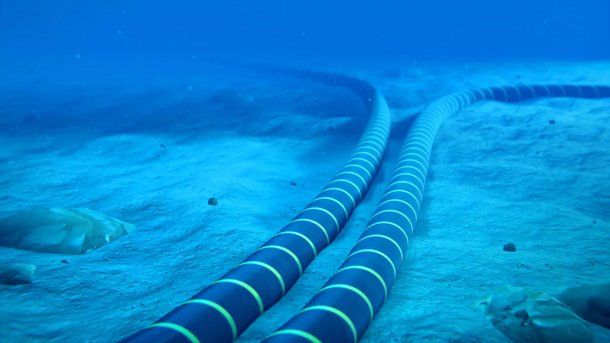AAE-1: Submarine cable in the Red Sea operational again
The damaged, important AAE-1 submarine cable in the Red Sea has been repaired. This was preceded by tough negotiations in the conflict area.

A submarine cable in the sea (rendering).
(Image: Vismar UK / Shutterstock.com)
The repair of the important AAE-1 undersea cable in the Red Sea, which connects Asia and Europe, has been completed. The approximately 25,000 km long fiber optic connection is now operational again, Bloomberg reported on Wednesday. At the same time, repairs are underway on two other submarine telecommunications cables.
The repairs were carried out by E-Marine, a subsidiary of the Emirates Telecommunications Group, writes Bloomberg. The company's repair ship, the Niwa, is currently working on restoring the Seacom and EIG submarine cables, which were also damaged.
According to current investigations, four of a total of 15 submarine cables were damaged in early March by an anchor of the cargo ship Rubymar, which the militant Huthi militia had sunk in the Red Sea. The cables lie close together in the Red Sea and could therefore be damaged together by the operation. The TGN submarine cable is also affected. Houthi militias from Yemen repeatedly carry out attacks on civilian shipping in the strait between Eritrea, Djibouti and Yemen.
Repairs after negotiations
Initially, it was not clear whether and when the repair work on the undersea cables could be carried out at all. The Yemeni waters are difficult to access due to the divided government in Yemen and the conflict zone in the Red Sea. However, negotiations between the cable operators and the two government parties in Yemen were able to come to a positive conclusion so that the repair work could begin. Things did not look good at first. The repair work on AAE-1 in particular was on the brink because the consortium member TeleYemen was alleged to have links to the Huthi, Bloomberg reports further.
The AAE-1 submarine cable is a particularly important communication link connecting Europe, the Middle East, India and Asia. The operators were forced to reroute data traffic as a result of the damage. This caused considerable costs.
However, the danger in the conflict zone has not been averted and further damage to the underwater connections is possible at any time. This is because the Houthi militias have stepped up their attacks on ships in the conflict area. The underwater structure is therefore still at risk - as are the shipping routes in the region as a whole.
It is still unclear when the remaining damaged undersea cables will be repaired.
(olb)